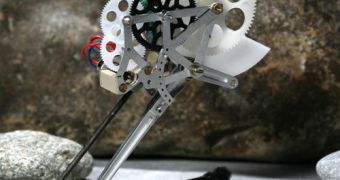A tiny robot resembling a grasshopper, measuring only 5 centimeters in height and weighting 7 grams, developed by the Swiss Federal Institute of Technology has recently broken the height record by jumping 27 times its own height. The previous record, held by a rather similar robot, was of only 17 times its own height.
Its developers, Dario Floreano and Mirko Kovac, reckon that the tiny robot could use its special abilities to explore disaster areas or other planets, while moving around just by hopping. It relies on two small legs powered by elastic energy stored up inside its two springs. The springs themselves are tensioned with the help of an electric motor taken from a vibration unit, such as those used in cell phones and pagers, which drives a gear system linked to the springs.
As the springs reach their maximum tensioning capability, they are released and so they push against the legs, thus propelling the robot into the air. Similarly to animals and insects, small robots with either legs or wheels may sometimes find even small obstacles insurmountable, unless of course they can hop. The winding mechanism can be powered by a single 10 mAh battery, takes 3.5 seconds to recharge the springs and will execute about 108 jumps before requiring a new battery.
The angle of the jump can be adjusted so the robot can jump either vertically or forwards, by modifying the angle of the joint connecting the two segments of the leg. For now, the robot has no means to control the direction of travel, nor can it land on its feet to prepare itself for the next jump, but further improvements should solve these problems in the near future.
Floarean says that the team plans to build a structure that will make sure the robot lands on its feet every time, and possibly some kind of wings so that it doesn't lose control while in the air. Additionally, solar panels, sensors and simple microcontrollers could make it completely autonomous and able to communicate with other similar robots in its vicinity.
"They have done excellent work, making this very light robot that can cover very long distance", says Umberto Scarfogliero from the Institute for Advanced Studies. Scarfogliero's team has developed a similar model last year, called Grillo, which was presented at the IEEE International Conference on Robotics and Automation.

 14 DAY TRIAL //
14 DAY TRIAL //